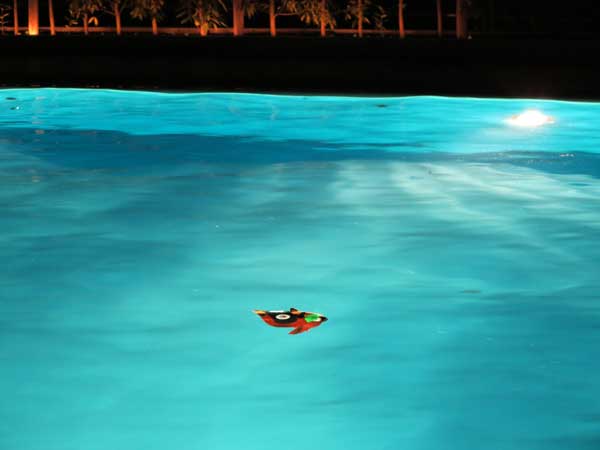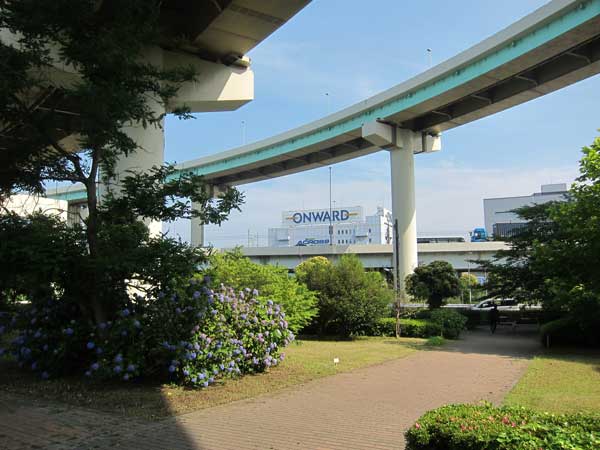Tanuki san made a splash during the Still City workshop, a Dutch-Japan exploration of post-growth urban life.

Tanuki san made a splash during the Still City workshop, a Dutch-Japan exploration of post-growth urban life.


芝のアウトドアのプールが閉まる前に、晩夏の東京タワーの写真をたくさんとりました。東京タワーは東京の数少ないランドマークですね。「ランドマーク」とは、自分の居場所がわかるような目立つ建物のことです。
Before the Shiba outdoor pool closed in mid-September, I spent more time admiring Tokyo Tower, both from the pool itself and from park surrounding it. I’ll post a few photos of this rare Tokyo landmark in the next week.

日本で携帯釣りプールを初めて見ました。楽しそうです。
I like this fishing game that’s often at Japanese festivals. Above is from Asagaya’s Tanabata festival. The scoop is made of a paper that quickly dissolves, so you want to catch as many fish as fast as you can.

Leaving the Tatsumi Metro station, I cross over one highway on a pedestrian bridge, while passing below several elevated highways intersecting with flyovers.
This Onward sign on top of a warehouse feels like a personal extortion to move through this jumble of smog and burning fuels. Onward also seems to capture this part of Tokyo’s role as a place of distribution by ship and tractor trailer. In this frenzy of “logistics,” I always wonder what’s being transported and to whom.
Fortunately, the trees planted decades ago muffle the noise somewhat, and part of this marginal land is used as a park, community vegetable garden, and Olympic level swimming pool.

最近「花吹雪」という表現をおぼえました。花見の季節が終わるころ、道はピンクの絨毯になります。悲しいのに、ハラハラ落ちている桜の花びらもとても素敵です。辰巳で。
I recently learned the word hanafubuki (花吹雪), which means flower blizzard. At the end of cherry blossom season, city pavement becomes a pink carpet. Along with watching the petals fall from the tree, this carpet is one of the best parts of hanami.
This photo is from a small park in Tatsumi, between Tokyo Bay and the southern edge of Shitamachi. It also borders Yumenoshima. Now that I discovered an Olympic pool in Tatsumi, I will be spending more time in this strange zone caught between nature, industry, trucking and warehouses, new and old housing, and stacked freeways.

都市とゼロックスという写真のワークショップに参加しました。たくさん勉強になって、楽しかったです。@TaroHirano77 や @VACANTbyNOIDEA や @toomuchmagazine や @sk8linus にありがとうございます。
I was fortunate to attend a photography workshop last week with the theme of Cities and Xerox. The event gathered about twenty Japanese creatives– including a sound engineer, high school art teacher, students, guidebook writer, book editor, lawyer, and salaryman– and together we created giant photographs layered together.
The workshop process was simple yet very fun. We were asked to take photographs on our way to the workshop. Then we each chose our best photographs for three topics: breakfast, landscapes, and people. The photographs were sent to FedEx Kinko to be blown up into various sizes. And then we worked together to layer them and staple them to a wood board, which would allow art center visitors to browse the images. While we waited for the photographs to be printed and biked back to the workshop, we also silkscreened t-shirts with the word “XEROXed.”
It’s great to see other people’s photographs and see how they view Tokyo. I was particularly struck by the breakfast images: everything from a traditional Japanese breakfast (many courses, including fish, rice, miso soup, pickles, etc) to a Denny’s, coffee, and those odd, squeezable jelly drinks in foil that are popular in Japan yet seem more suited to outer space. I was the only foreigner, but felt very welcomed by the organizers and participants.
The workshop was led by accomplished photographer Hirano Taro, who became famous for taking photographs of empty pools in California used by skateboarders. The workshop took place at Vacant art space in Harajuku as part of a series of Romantic Geography events created by Too Much Magazine’s Tsujimura Yoshi.
You can see our photographs through May 22 at Vacant. There are also coffee and beeswax events coming up. I had a fantastic time, and was very impressed with how accessible, fun and collaborative this event was.




原発についてたくさん勉強になりましたけれども、毎日の生活とエネルギーの本当のコストの問題が残っています。
A fascinating short video from IDG News Service’s @martyn_williams shows the inside of a functioning nuclear power plant in Japan. It’s Kashiwazaki Kariwa, the world’s largest nuclear plant, on the Japan Sea, also known as the East Sea of Korea.
In the past two weeks, we have all learned many details about nuclear power generation: from containment vessels to doughnut-shaped torus, steam venting, cooling pools, basement pumps and generators, and dangers from radioactive iodine and cesium. While the Daichi survived the earthquake, several days without electricity led to pressure build-up, exposed fuel rods, explosions, and radioactive releases.
Most Japanese school children are given tours of nuclear facilities to encourage familiarization and acceptance. Watching the video above, I am struck by the incongruity of these images of rational organization with the recent realization that a lack of power can quickly turn these engineering marvels into a grave threat to human existence.
It is interesting that the video above, and I am certain the hundreds of school tours, fail to mention that the reactors serve a second and equally dangerous function: they are the storage locations for spent nuclear rods. While the active rods have control rods and secured cases, the spent rods seem to be in less protected parts of the reactors.
The explosions at the Daichi nuclear power plant in Fukushima have literally blown the lid off a scary reality that is normally kept far from conscious thinking. Everyone knows that nuclear waste and the long-term dangers it poses are the by-product of this “clean,” low carbon energy. What is less known is that these spent rods remain near population centers and alongside ocean coasts that routinely experience tsunamis and earthquakes. They remain hidden from view within the plants because the rods are difficult to transport safely and few communities would welcome them.
I expect that as the crisis becomes less acute, there will be more attention to the questions of how much energy we need, how to balance what is possible with what is prudent, and how to make visible the true costs of energy production, including the wars used to “secure” petroleum from hostile regions, and the potential contamination of people and land from nuclear power and waste.
In the coming weeks, this blog will focus on recovery from the nuclear crisis, including increased city bicycling, reduced power consumption, and other positive developments. I will also show signs of Tokyo’s spring, and other evidence that the natural world continues in spite of human activity.
